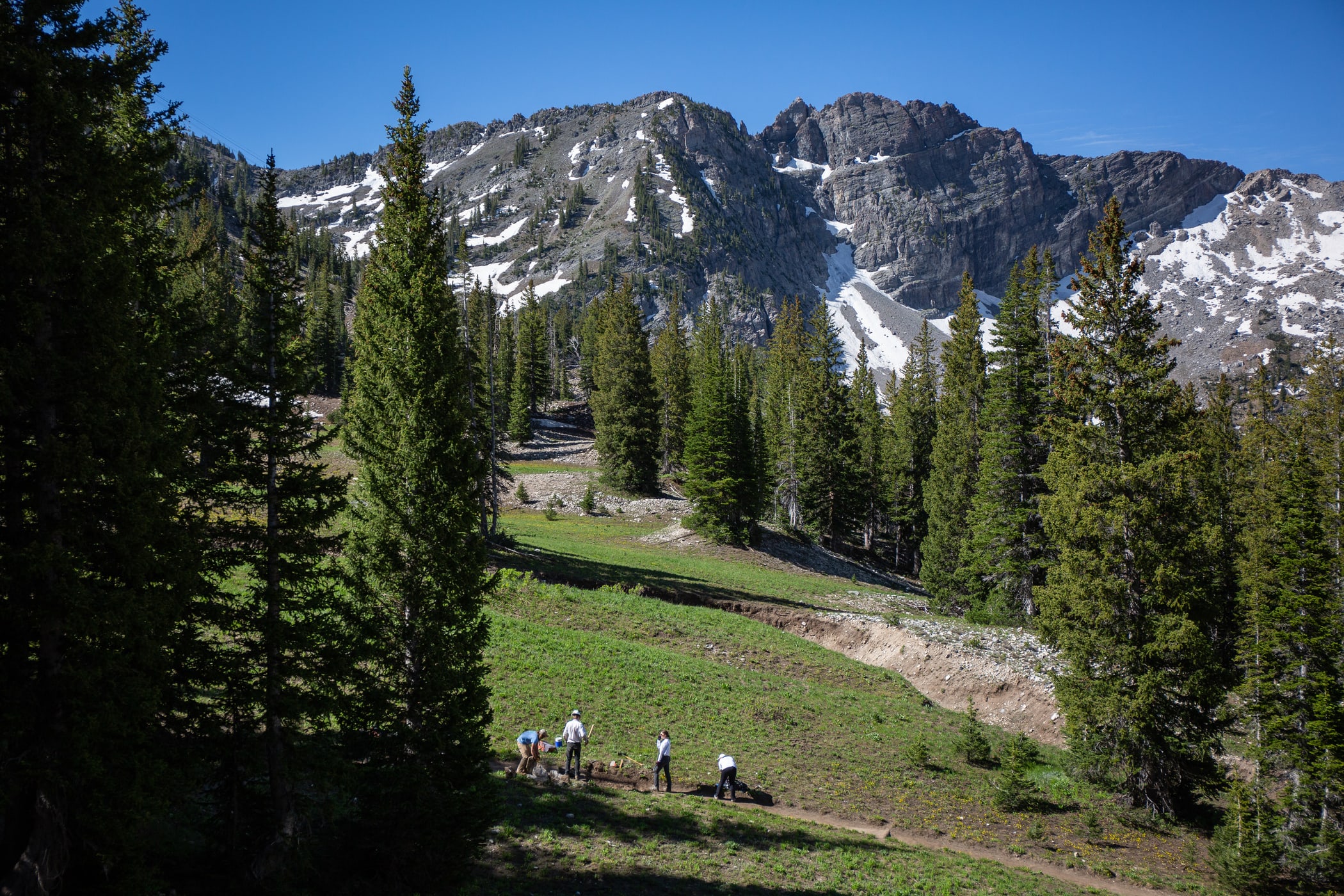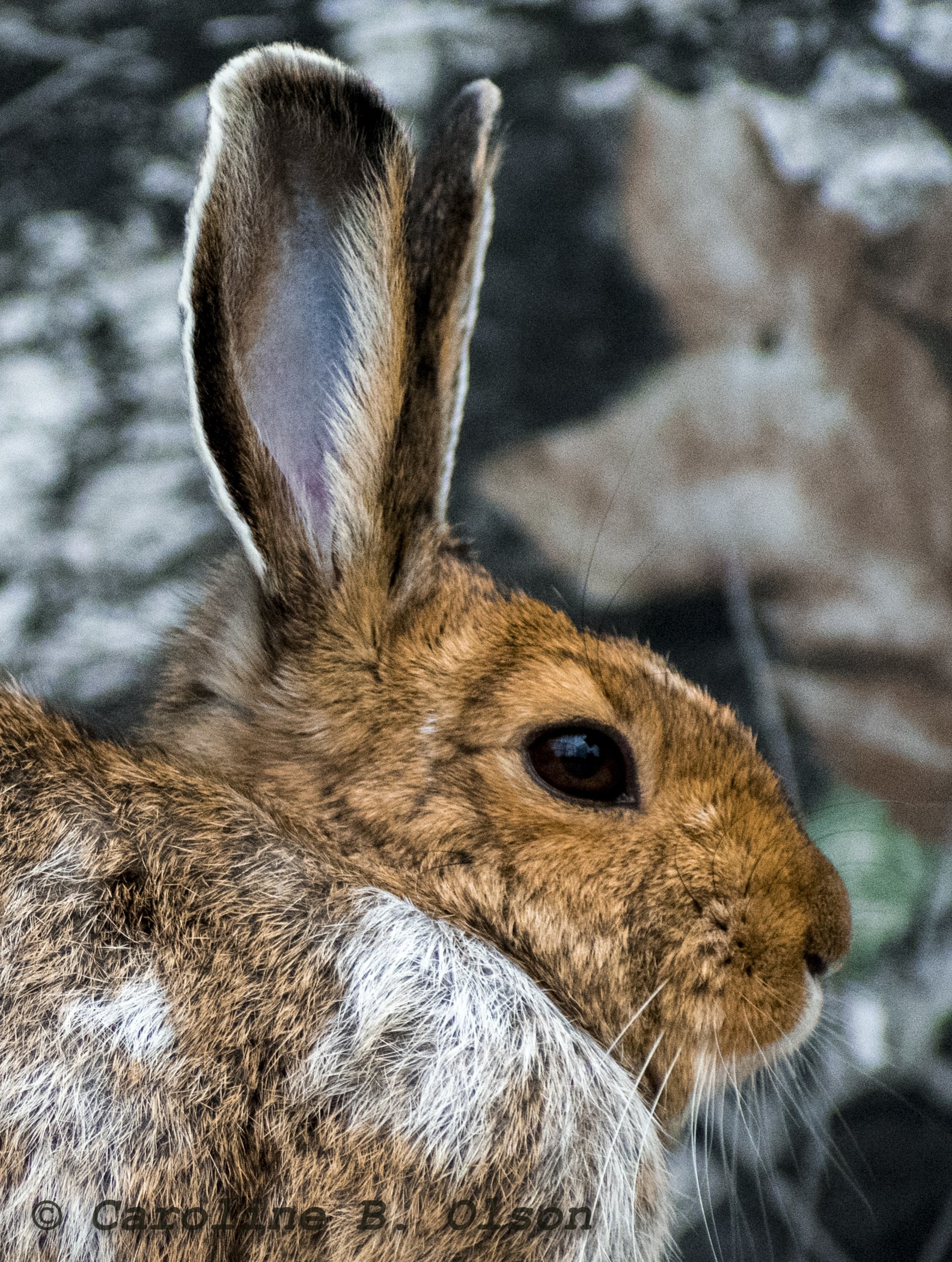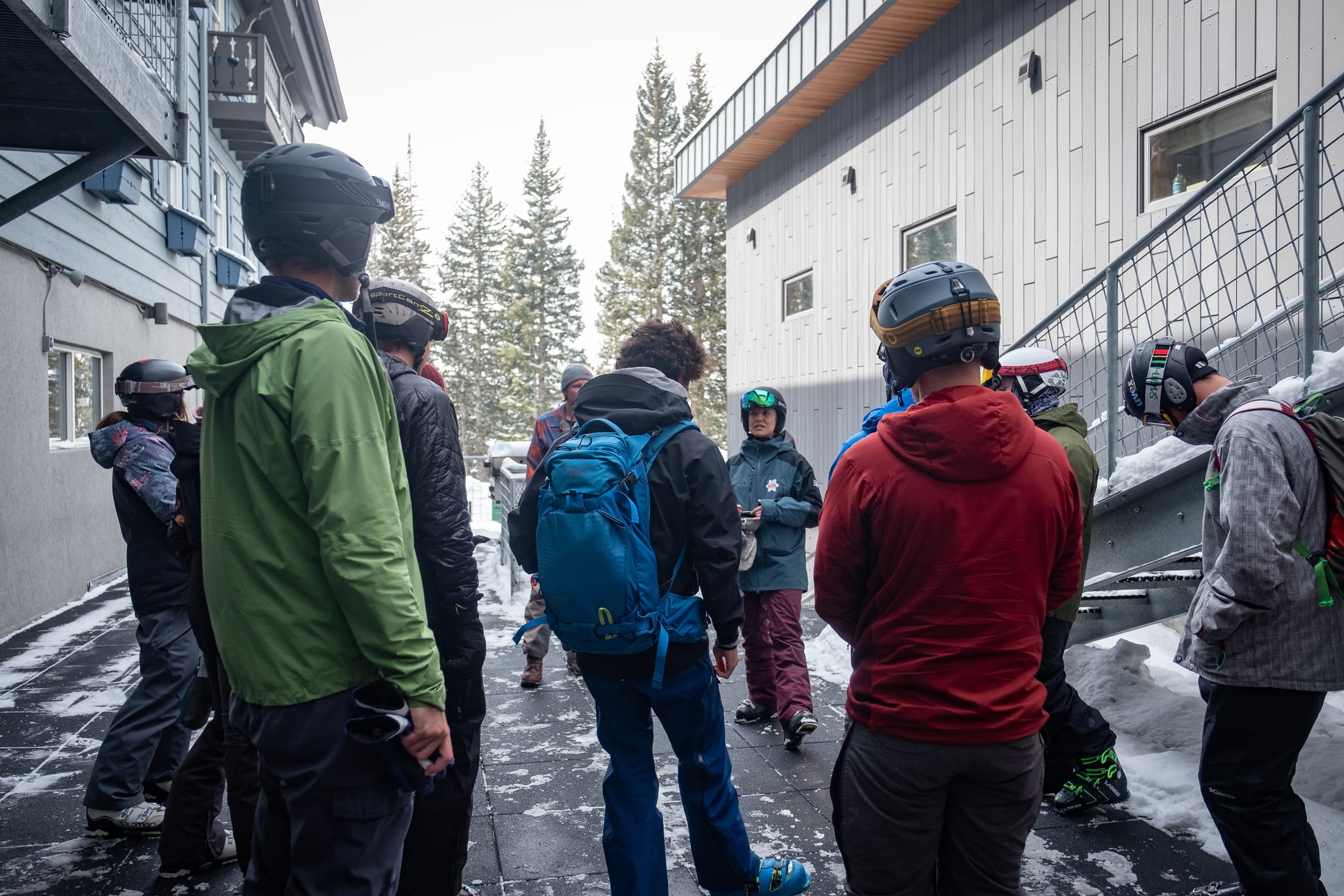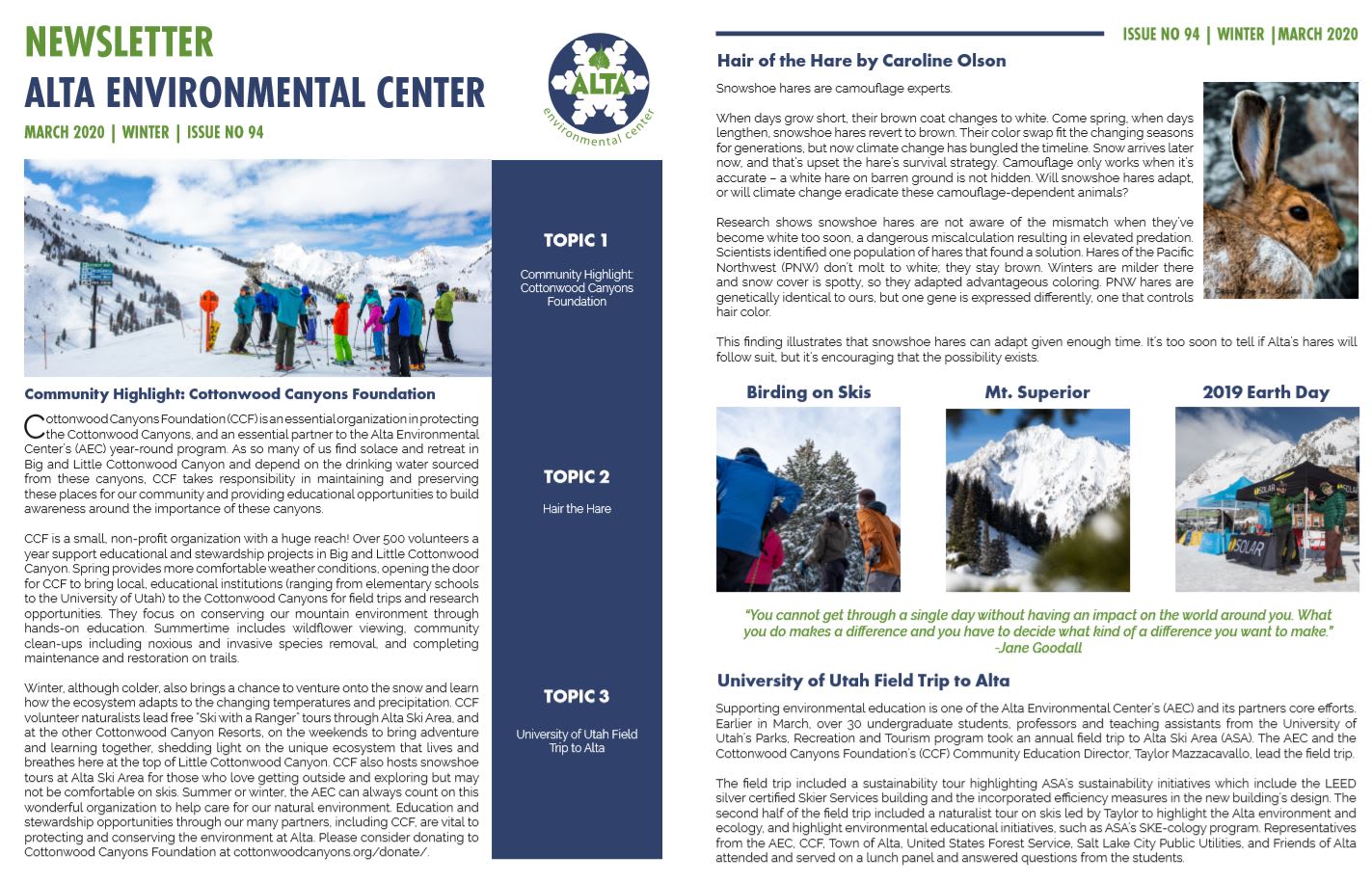Issue no. 94
Community Highlight - Cottonwood Canyons Foundation
Cottonwood Canyons Foundation (CCF) is an essential organization in protecting the Cottonwood Canyons, and an essential partner to the Alta Environmental Center’s (AEC) year-round program. As so many of us find solace and retreat in Big and Little Cottonwood Canyon and depend on the drinking water sourced from these canyons, CCF takes responsibility in maintaining and preserving these places for our community and providing educational opportunities to build awareness around the importance of these canyons.
CCF is a small, non-profit organization with a huge reach! Over 500 volunteers a year support educational and stewardship projects in Big and Little Cottonwood Canyon. Spring provides more comfortable weather conditions, opening the door for CCF to bring local, educational institutions (ranging from elementary schools to the University of Utah) to the Cottonwood Canyons for field trips and research opportunities. They focus on conserving our mountain environment through hands-on education. Summertime includes wildflower viewing, community cleanups including noxious and invasive species removal, and completing maintenance and restoration on trails.

Winter, although colder, also brings a chance to venture onto the snow and learn how the ecosystem adapts to the changing temperatures and precipitation. CCF volunteer naturalists lead free “Ski with a Ranger” tours through Alta Ski Area, and at the other Cottonwood Canyon Resorts, on the weekends to bring adventure and learning together, shedding light on the unique ecosystem that lives and breathes here at the top of Little Cottonwood Canyon. CCF also hosts snowshoe tours at Alta Ski Area for those who love getting outside and exploring but may not be comfortable on skis. Summer or winter, the AEC can always count on this wonderful organization to help care for our natural environment. Education and stewardship opportunities through our many partners, including CCF, are vital to protecting and conserving the environment at Alta.
Please consider donating to Cottonwood Canyons Foundation
Hair of the Hare - Snowshoe hares are camouflage experts, seasonal chameleons
BY: CAROLINE OLSON
In late autumn, when daylight hours dwindle, snowshoe hares change color. The trigger for their semiannual transformation is the photoperiod or duration of light in the day. When the days grow short, their mottled brown summer coat is shed and replaced hair by hair, until the animal sports a pelage of pure wintery white. Come spring, when the days grow longer, the snowshoe hare reverts to brown.

Snowshoe hares’ color swap aligned with the first snow and last thaw for countless generations, but today climate change has bungled the timeline. Winter snow is arriving later than it used to and that shift is upsetting the survival strategy snowshoe hares rely on. Camouflage only works when it’s accurate – a white snowshoe hare on a patch of brown, barren ground is anything but hidden.
Scientists are interested in color-changing animals like the snowshoe hare because they directly affected by climate change. Will snowshoe hares adapt, or will late-arriving winters spell the beginning of the end for animals whose survival depends on blending in?
One thing is certain, mismatched snowshoe hares are sitting ducks. When facing danger, all animals execute one of three responses: fight, flight, or freeze. When a snowshoe hare detects danger, it stays put, statue-still, using camouflage as the first line of defense. Research shows that snowshoe hares are not aware of the mismatch when they’ve become white too soon. This dangerous miscalculation results in greater success for the hare’s predators.
One population of snowshoe hares has developed a solution. The snowshoe hares of the Pacific Northwest (PNW) molt at the same photoperiod as Alta’s local population, but rather than becoming white in the winter, they molt from brown to brown. In the PNW, winters are mild compared to the interior and snow cover is spotty. If PNW snowshoe hares turned white in the fall, they might face a season of more mismatch than not, and so they remain brown.
Genetic sequencing has revealed the source of this adaptation. PNW snowshoe hares are genetically identical to interior hares, but one gene is expressed differently, a gene that controls for the presence or absence of hair color. PNW hares have adapted to keep this gene “on” throughout the year, whereas interior hares have not. This finding illustrates how a local population can adapt to climatic variation, given enough time and exposure. Will Alta’s snowshoe hares adapt similarly? It’s too soon to tell. But looking forward, it’s encouraging to know that the possibility is out there.
“You cannot get through a single day without having an impact on the world around you. What you do makes a difference and you have to decide what kind of a difference you want to make.”
- Jane Goodall
University of Utah Field Trip to Alta
Supporting environmental education is one of the Alta Environmental Center’s (AEC) and its partner's core efforts. Earlier in March, over 30 undergraduate students, professors and teaching assistants from the University of Utah’s Parks, Recreation and Tourism program took an annual field trip to Alta Ski Area. The AEC and the Cottonwood Canyons Foundation’s (CCF) Community Education Director, Taylor Mazzacavallo, lead the field trip.

The field trip included a sustainability tour highlighting Alta's sustainability initiatives which include the LEED Silver Certified Skier Services building and the incorporated efficiency measures in the new building’s design. The second half of the field trip included a naturalist tour on skis led by Taylor to highlight the Alta environment and ecology and highlight environmental educational initiatives, such as Alta Ski Area's SKE-cology program. Representatives from the AEC, CCF, Town of Alta, United States Forest Service, Salt Lake City Public Utilities, and Friends of Alta attended and served on a lunch panel and answered questions from the students.


Add Your Comment